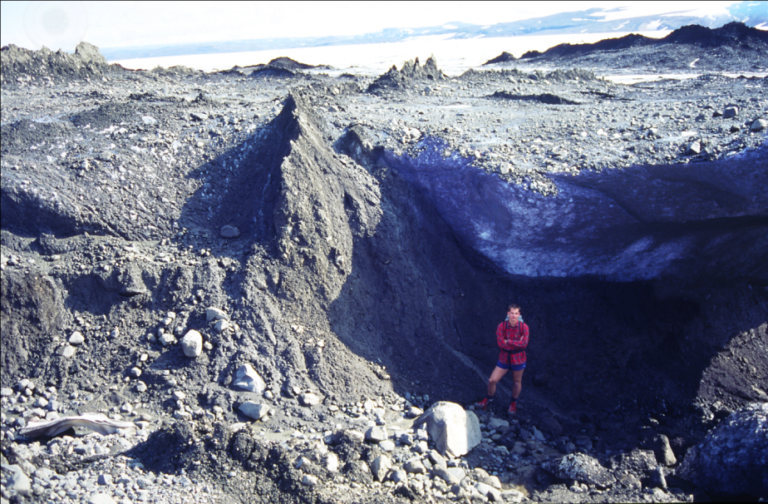Project Description
Crevasse squeeze ridges (CSRs) are somewhat enigmatic landforms, though our understanding of their formation and preservation mechanisms are now near fully understood1. Initially they were linked only with surging glaciers but with improvements in the imaging of the earth surface and sea floor it has become apparent that they are also formed beneath ice streams2. Their formation is driven by high basal water pressures and fast ice flow which in combination lead to the formation of bottom-up basal crevasses that become filled with sediment sourced from the glacier bed. Once formed, preservation then requires a switch in the ice dynamics such that the ice slows down/stops and deglaciation occurs passively, otherwise they will not be preserved. Their presence in the landform record therefore provides evidence for highly dynamic and potentially unstable ice flow. Such knowledge is important for understanding the dynamics of past ice sheet deglaciation and surging glaciers. However, the reconstruction of ice dynamics from CSR networks has, to date, been underexplored.
This project will initially undertake a systematic review of the literature to compile a database on CSR distribution and formation mechanisms that will likely form the basis for an initial review paper. From this database, key CSR sites at active glacier margins and in palaeo settings will be mapped and analysed in a GIS environment, using free to access satellite imagery and DEMs, to generate datasets on their metrics, geometries and the related/inferred ice dynamics. These data will include, for example, ridge orientation, segment lengths, relief, and ice flow direction determined from subglacial lineations (flutes and MSGL). Such data will allow basal fracture patterns to be reconstructed and the exploration of how these relate to ice dynamics (e.g. ice thickness, location and patterning within flow units, sediment volume etc.) and an assessment of how their dimensions scale in relation to ice mass geometry. Various approaches will be investigated to assess the potential for deriving quantitative estimates of past ice dynamics using preserved CSR networks, e.g. estimates of ice thicknesses linked to a geotechnical assessment of potential overburden pressure, and estimations of the orientations and ratios of tensile and shear stresses derived from CSR fracture patterns3.
Depending on the interests of a successfully applicant and the agreed direction of the research there is the possibility of fieldwork, thought this is not absolutely essential. Fieldwork provides the opportunity for in situ investigations of CSR sedimentology, physical and geotechnical properties, coupled with the opportunity to generate high resolution DEMs via drone and/or echosounder surveys. Such data, specifically linked to recently exposed terrestrial and/or sub-aqueous (preserved below wave base) CSR networks will facilitate better evaluations of the volume of sediment consumed from the bed by the CSRs, which may influence the switch in ice dynamics linked to their survival. Possible field locations for the investigation of recently exposed landforms include Svalbard and Iceland, while excellent palaeo examples can be found in areas glaciated by the Laurentide ice sheet in North America. There is the potential for both onshore and offshore fieldwork which could be related to recent or palaeo landforms.
CANDIDATE BACKGROUND
The ideal candidate for this position will have a background in geography and/or geology with demonstrable skills in one or more of the following: GIS, remote sensing, fracture mapping, glacial geomorphology/geology, glaciology, sedimentology.
They will be enthusiastic and happy to work as part of a team and to engage with the vibrant cryosphere group in Aberdeen and more widely with the other QUADRAT students and related training. Fieldwork will ideally form a component of this project so evidence of previous fieldwork and a desire to work in potentially remote and cold locations will be advantageous.
Clear scientific direction will be provided during the early part of the PhD with an expectation that the student takes ownership of as it progresses and directs it towards their developing specialist interests.
Photo by Brice Rea, University of Aberdeen
Supervisors
Brice ReaPrimary Supervisor: | Profile: Brice Rea Email: b.rea@abdn.ac.uk Institution: University of Aberdeen Department/School: School of Geosciences |
Andrew NewtonSecondary Supervisor: | Profile: Andrew Newton Email: A.Newton@qub.ac.uk Institution: Queen's University, Belfast Department/School: School of Natural and Built Environment |
Additional Supervisor: | Dr Bartosz Kurjanski, University of Aberdeen, School of Geosciences Email: bkurjanski@abdn.ac.uk |
Matteo SpagnoloAdditional Supervisor: | Profile: Matteo Spagnolo Email: m.spagnolo@abdn.ac.uk Institution: University of Aberdeen Department/School: School of Geosciences |
Additional Supervisor: | Dr Harold Lovell, University of Portsmouth Email: harold.lovell@port.ac.uk |
References
- Rea, B.R. and Evans, D.J.A. (2011) An assessment of surge-induced crevassing and the formation of crevasse squeeze ridges. Journal of Geophysical Research, 116, F04005, doi: 10.1029/2011JF001970.
- Kurjanski, B., Rea, B.R., Spagnolo, M., Winsborrow, M., Cornwell, D.G., Andreassen, K., Howell, J.A. (2019) Morphological evidence for marine ice stream shutdown, central Barents Sea. Marine Geology, doi: 10.1016/j.margeo.2019.05.001
- J. van der Veen (1999) Crevasses on glaciers. Polar Geography, 23:3, 213-245, DOI: 10.1080/10889379909377677
QUADRAT Themes
- earth-systems






















































